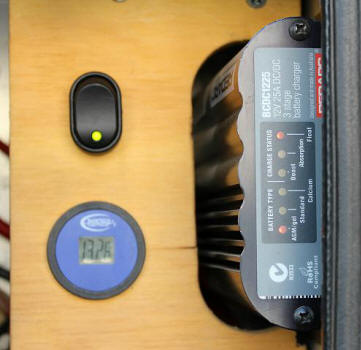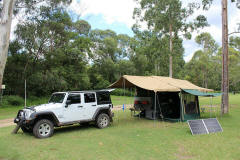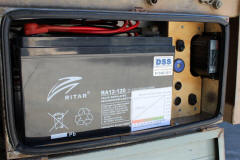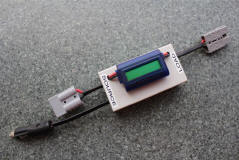|

redarc
bcdc1225
feedback

in the process of
topping the batteries up to 100% capacity from solar
I installed a Redarc BCDC1225
DC-DC charger in the camper trailer last July & since that time we
have managed to give it a good test in varying situations including
camping over several days at a time & also on the road travelling
from day to day. This is where the 3 stage DC-DC charger really
comes into it own, recharging the remotely located batteries to 100% capacity while
driving during the day.
You will find my install write up
on the tech tips page at
http://www.campertrailers.org/bcdc1225_install.htm This explains
how the charger works as a 3 stage DC-DC charger from the vehicles
alternator & also as a MPPT solar regulator from the solar panel.
power
consumed
Our 40 litre Engel fridge is run as
a fridge from the camper trailer batteries in camp usually at the
one & a half setting with an internal temperature reading on the
inbuilt thermometer of two degrees. At this setting it uses around
20 amp hours cycling in & out to maintain that temperature. I
took a reading over a 24 hour period using a Watt's Up meter run
inline. The fridge was sitting just off the ground in the shade of
our camper awning with an ambient temperature
ranging from 20 degrees overnight to 28 during the day.
On another day with a daytime
ambient of 20 degrees & an overnight of 10 degrees, the fridge uses
10 amp hours.
Carolís Cpap is a 12volt model & uses 1.2 amps
with the humidifier set at low. Thatís around 10 amp hours for the
night. Of course the higher the humidifier setting the
more power is used which can double the power draw.
The Korr LED lights use a maximum
of 2 amp hours for the night. After tea & washing up they are then turned down to a
glow with the dimmer switch while sitting around the campfire
reducing the power consumption.
So in theory we need around 30 to
40 amp
hours to run the fridge & Cpap without taking into account
recharging the laptop, UHF handhelds, phones or camera batteries.
We use 12volt rechargers for all of these accessories & not via an
inverter.
the system
The two 120 amp hour Rita AGM deep
cycle batteries are charged via two 65 watt Kyocera folding panels
using a Plasmatronics PL1210 regulator on the back of the panels
with
a ten metre length of 6mm twin core cable when camped.
Using Richardís Solar Spreadsheet we need in theory, around six
hours of sun plus to fully recharge the batteries.
http://www.campertrailers.org/solar_spreadsheet.htm
Anyone who owns a similar system &
draw knows just how much effort is involved in chasing this amount
of sun for the day if you intend to stay for a period of time in the
one spot while bush camping & maintain a 100% battery capacity, just
in case there are a couple of rainy days around the corner. With
just a voltmeter it is hard to see the true capacity of the batteries when they are
charging as you are only reading the surface charge.
If we were on a trip & after four
or five days bush camping we would have to drop into a caravan park
& connect to a powered site to use our 240volt 25amp charger & fully
recharge the batteries to keep them healthy.
solar
input to redarc
bcdc1225
With the
Redarc BCDC1225 installed, the batteries are now charged in a
shorter time period using the unregulated input from the solar panels via the inbuilt MPPT solar regulator
side of the charger.
Usually by mid morning the charger indicates the batteries are in
float mode.
At the Macquarie Woods CamperTrailers weekend meet last November we had
an entire day that was overcast & drizzle, resulting in the batteries only receiving
half an amp input at best. The next morning with the sun shining the charger
showed it was in boost mode & by mid afternoon had gone into float.
We would never been able to recover that amount of energy &
therefore would be a day behind, forcing us into a caravan park
powered site if on an extended trip.
Overall the
Redarc BCDC1225 means we are now 12volt self sufficient when the sun shines &
we do not have to use a caravan park site to
maintain the batteries when on the road. Staying more in bush camp
sites suits us better.
alternator
input to redarc
bcdc1225
Over a seven
day camp there was only a couple of hours solar input over the last
three days with the Redarc in continual boost charge. It was hard to
say what the battery capacity was on the last morning via a
voltmeter as the fridge & the Cpap had been on overnight. When
I started the Jeep which has a 180 amp alternator, the BCDC1225
showed it was in boost with a solid red light indicating max charge.
I checked
the input via the 6B&S cable from the charger to the camper
batteries with a clamp meter. It was putting out 28 amps. This is
the most I have ever seen & shows just how low the batteries must
have been. While the charger has an output of 25 amps, the
instruction manual says it can put out up to 30 amps.
An hour later I pulled over to see what the charger was up to & it
had gone into absorption mode & was now injecting 10amps into the
batteries. Another hour or so later it was time for a cuppa & the
batteries were in float with 0.2 amps slowly topping them up.
understanding
At times a
little knowledge can be dangerous especially for someone like me who wants to
know how things work. At first I was a little concerned that after a
night with the fridge & Cpap running, the BCDC1225 was not going
into boost mode to charge the batteries & was only putting out a
float charge as indicated by the display panel. It was handy having Redarc's Stuart Peddle & Wayne Magennis present two workshops at
last years CamperTrailers Group's Wellington national meet as it
gave me the opportunity to ask questions.
Stuart's
first question was are your batteries full. The answer was
of course yes. He replied then the charger is doing its job. The
BCDC1225 monitors the capacity of the batteries & will charge
accordingly, not necessarily at full charge. Topping the batteries
up at low amps instead of 25 amps is all that is needed to bring the
batteries up to 100% capacity in these circumstances.
 |
 |
 |
|
solar input |
redarc bcdc1225
|
watts up meter |
update
The
Redarc
BCDC1225 DC to DC charger would have to be on top of the list
for the best 12volt item we have installed in our camper trailer. On
our recent trip over four weeks duration, the charger once again
proved its worth by maintaining our camper trailer batteries to full
charge whatever the situation. We were on the move most days with
only short drives to the next bush campsite and several two day
camps where we could place the portable solar panel in the sun.
The 12volt system in the camper trailer is based on two 120 amp hour
Rita AGM deep cycle batteries with an average daily power
consumption of around 30 amp hours. Using a
Watts Up
meter we know the 12volt Cpap machine uses 10 amp hours
overnight while the
40 litre
Engel fridge, which is run as a fridge, uses between 10 to 20
amp hours over twenty-four hours depending on the season. There is also the charging of the
laptop, camera and mobile phone batteries.
An
Enerdrive battery monitor is used to give us a accurate
indication of the batteries state of charge. Using the rule of thumb
not to allow the deep cycle batteries to discharge below 50%
capacity allows us to camp for a number of days if there is no sun
available for the solar panel.
When camped the Redarc BCDC1225 easily sees the batteries fully
changed by after lunch from the 130 watt Kyocera folding panel
thanks to the inbuilt MPPT solar regulator.
While driving the 3 stage DC to DC charger really comes into it own,
recharging the remotely located batteries to 100% capacity from the
vehicles alternator.
The Redarc BCDC1225 allows us the freedom to bush camp and not
having to visit a caravan park to charge the batteries from the 250
volt charger. We love our bush camping, whether it be in a national
park, state forest or private property.
article by Rob
march 2013
updated
July 2013
updated
July 2016
|